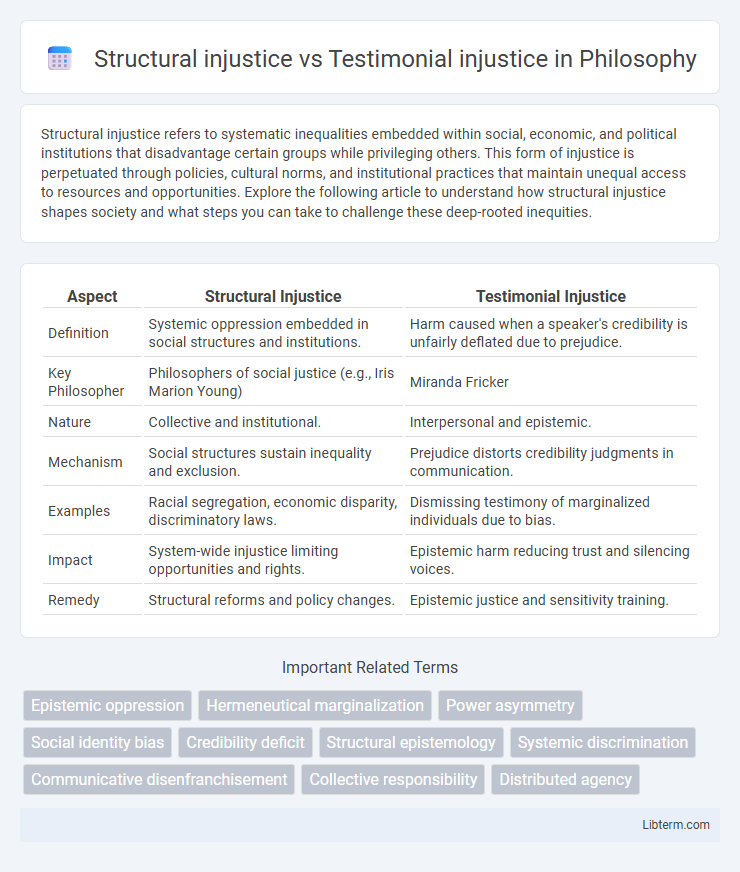Structural injustice refers to systematic inequalities embedded within social, economic, and political institutions that disadvantage certain groups while privileging others. This form of injustice is perpetuated through policies, cultural norms, and institutional practices that maintain unequal access to resources and opportunities. Explore the following article to understand how structural injustice shapes society and what steps you can take to challenge these deep-rooted inequities.
Table of Comparison
| Aspect | Structural Injustice | Testimonial Injustice |
|---|---|---|
| Definition | Systemic oppression embedded in social structures and institutions. | Harm caused when a speaker's credibility is unfairly deflated due to prejudice. |
| Key Philosopher | Philosophers of social justice (e.g., Iris Marion Young) | Miranda Fricker |
| Nature | Collective and institutional. | Interpersonal and epistemic. |
| Mechanism | Social structures sustain inequality and exclusion. | Prejudice distorts credibility judgments in communication. |
| Examples | Racial segregation, economic disparity, discriminatory laws. | Dismissing testimony of marginalized individuals due to bias. |
| Impact | System-wide injustice limiting opportunities and rights. | Epistemic harm reducing trust and silencing voices. |
| Remedy | Structural reforms and policy changes. | Epistemic justice and sensitivity training. |
Introduction to Structural and Testimonial Injustice
Structural injustice refers to the systemic and institutionalized inequalities embedded within social, economic, and political frameworks that disadvantage certain groups. Testimonial injustice occurs when a speaker's credibility is unjustly deflated due to prejudice, leading to the unfair dismissal or undervaluation of their knowledge or testimony. Understanding both concepts requires recognizing how power imbalances influence the distribution of credibility and the perpetuation of social inequalities.
Defining Structural Injustice
Structural injustice refers to systemic and institutional patterns that create and maintain social inequalities, often embedded within legal, economic, and political frameworks. It manifests through unfair distribution of resources, opportunities, and power, disproportionately affecting marginalized groups. Unlike testimonial injustice, which centers on credibility deficits in individual interactions, structural injustice involves broad societal mechanisms that perpetuate disadvantage.
Understanding Testimonial Injustice
Testimonial injustice occurs when a speaker's credibility is unfairly deflated due to prejudice, undermining the reliability of their testimony. This type of injustice typically targets marginalized groups, reinforcing social hierarchies and perpetuating unequal power dynamics. Understanding testimonial injustice involves recognizing how epistemic authority is distributed inequitably based on identity markers like race, gender, or class.
Key Differences between Structural and Testimonial Injustice
Structural injustice refers to systemic inequalities embedded in social, economic, and political institutions that disadvantage certain groups, whereas testimonial injustice occurs when a speaker's credibility is unfairly diminished due to prejudice. The key difference lies in scale and manifestation: structural injustice operates at a societal level, perpetuating broad patterns of oppression, while testimonial injustice is an interpersonal issue concerning the reliability granted to individuals' statements. Structural injustice shapes the conditions that facilitate testimonial injustice, linking institutional bias to individual credibility assessments.
Social Mechanisms Driving Structural Injustice
Structural injustice arises from ingrained social mechanisms such as institutional policies, economic inequalities, and systemic discrimination that perpetuate unequal access to resources and opportunities. Testimonial injustice occurs when a speaker's credibility is unfairly diminished due to prejudice, often intersecting with structural factors like racism or sexism embedded in societal norms. Understanding structural injustice requires analyzing power dynamics and social structures that sustain marginalization beyond individual interactions, highlighting the collective nature of oppression.
The Role of Power in Testimonial Injustice
Testimonial injustice occurs when a speaker's credibility is unfairly deflated due to prejudice, often linked to power dynamics within social interactions. Structural injustice, by contrast, refers to systemic patterns of disadvantage embedded in institutions, influencing who holds authority and whose voices are marginalized. Power shapes testimonial injustice by granting or withholding epistemic authority, reinforcing stereotypes that discredit marginalized groups and perpetuate unequal recognition in knowledge exchange.
Real-World Examples of Structural Injustice
Structural injustice occurs when systemic inequalities embedded in societal institutions disproportionately disadvantage certain groups, such as racial minorities facing disparities in criminal justice sentencing or marginalized communities lacking access to quality healthcare. Testimonial injustice involves the unfair discrediting of a person's knowledge due to prejudice, exemplified when a woman's expertise in a male-dominated workplace is unjustly doubted. Real-world examples of structural injustice include redlining in housing policies that lead to segregated neighborhoods and unequal educational opportunities, as well as systemic wage gaps perpetuated by discriminatory labor practices.
Case Studies of Testimonial Injustice
Testimonial injustice occurs when a speaker's credibility is unfairly deflated due to prejudice, often examined through case studies involving marginalized groups whose voices are dismissed or doubted. For example, in the case of racial profiling, witnesses from minority communities are frequently disbelieved, leading to systemic bias in legal proceedings. Structural injustice encompasses broader institutional practices that perpetuate inequality, while testimonial injustice specifically targets epistemic harm inflicted during communicative interactions.
Interactions between Structural and Testimonial Injustice
Structural injustice manifests through systemic inequalities embedded in social institutions, influencing access to resources and opportunities unevenly. Testimonial injustice occurs when individuals are discredited or their knowledge devalued due to prejudiced biases during interpersonal interactions. These injustices intersect as structural inequities shape the social contexts in which testimonial injustices arise, reinforcing patterns of marginalization and silencing marginalized voices within epistemic exchanges.
Addressing and Mitigating Both Forms of Injustice
Addressing structural injustice requires systemic reforms that target institutional policies and social norms perpetuating inequality, such as equitable access to education, healthcare, and legal protections. Mitigating testimonial injustice involves fostering environments where marginalized voices are actively heard and trusted, through training in epistemic humility and techniques that counteract implicit biases in communication. Combining policy changes with cultural shifts creates a comprehensive strategy to dismantle both structural barriers and interpersonal credibility deficits.
Structural injustice Infographic

 libterm.com
libterm.com